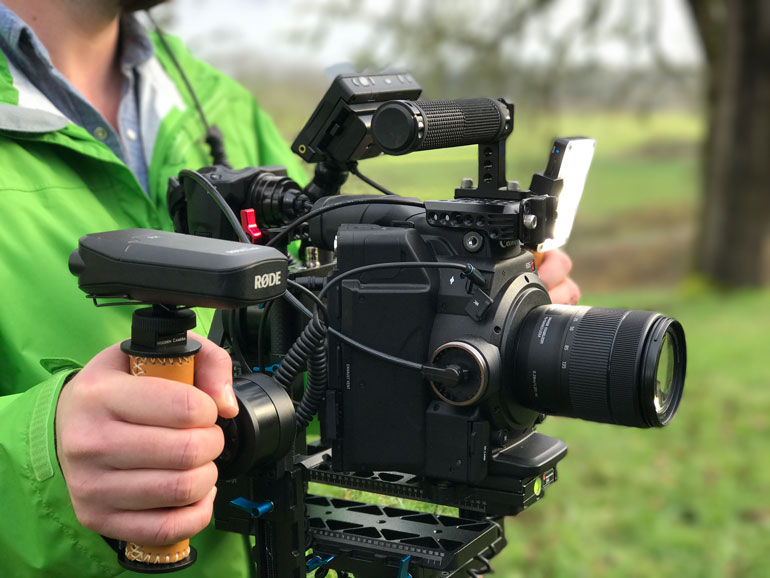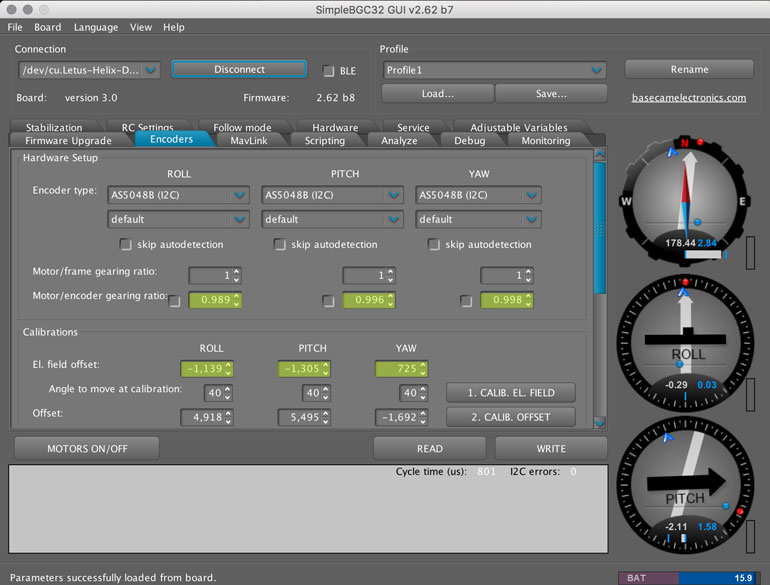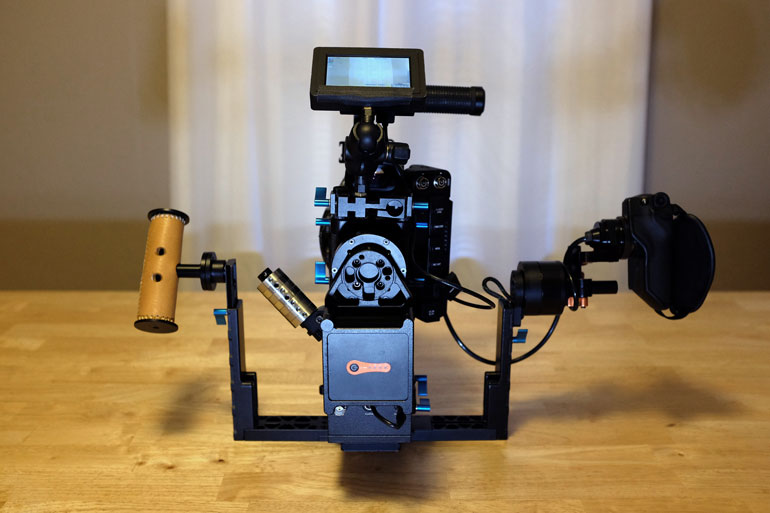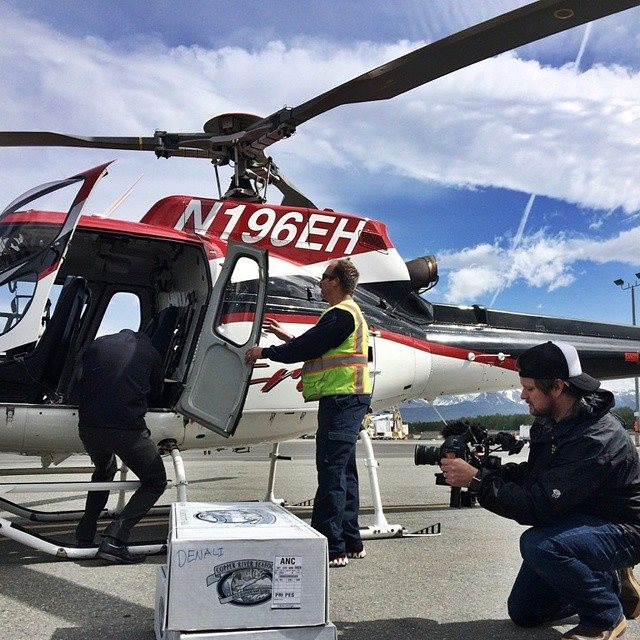Letus Gimbal Setup
Hands down, the best thing about the Letus Helix Standard and Letus Helix Jr gimbals is their ease of use, even for heavier cameras that would typically require elaborate camera gimbal rigs.
But what many videographers new to brushless gimbals quickly realize is that the PID tuning stage of setting up your camera on a gimbal can be challenging, if not an utterly frustrating task.
For small, lightweight cameras, PID tuning is often not an issue, since any default out-of-the-box setting can usually handle a small payload without needing much tuning at all.

A Canon C300 mark II on a Letus Helix Standard
What makes the Helix Jr and Standard special is that they can take heavier cameras such as the Sony FS5 and FS7, Canon C100 and C300, Ursa Mini and RED cameras, and just about any DSLR with a standard or cine lens.
But with heavier cameras comes a more delicate approach to PID tuning, and that applies to any brushless gimbals out today, not just the Letus Helix Jr and Helix Standard camera gimbals.
So to help you jump past this hurdle, here are step by step guides for loading the PID settings we've been using for the Canon C100 on a Helix Junior, and settings for the Canon C300 mark II on a Helix Standard.
Gimbal PID Explained
Maybe now is a good time to jump way back to the beginning, and ask: What is PID tuning? And how can I use it to get rid of vibration?
Letus' Ken Lawler has prepared some very informative slides describing PID settings in layman terms.
Part 1: What is PID and how do you typically approach tuning?
Part 1: When to use filters and power settings to eliminate buzzing?
The main takeaway with these slides is that every camera setup requires a different amount of power and PID settings on each motor. You could have the same camera rig on two gimbals, but one uses an external monitor that adds weight to the roll axis, so the power required to stabilize it would be different.
More importantly, if you're reading this because you have an encoder version of the Helix Jr or Standard, pay attention to the part about D settings and filters. In our experience (which we go into detail later in this post), the encoded motors required very high D settings, which necessitated a mix of notch, low pass, and D-term filters to eliminate buzzing.
Finally, it's essential to approach PID settings as an ongoing experiment in finding the best settings for your particular camera. You try a setting, hit "write," give the gimbal a spin, set it down and try another setting until you get closer and closer to pretty good settings.
Experienced PID tuners (like the folks at Letus) have done this thousands of times, but when we're watching them at work, they aren't hitting the perfect numbers at the first attempt. So, be patient, keep trying different settings, and eventually you'll start to get at least a basic understand of what's working (and what isn't).
Letus Helix Jr Non Encoded PID Settings for Canon C100
Truthfully, when we first got our original Helix Jr a few years ago, we were completely new to the camera gimbal world. But after spending a day learning how to balance our C100 on the gimbal, and a few minutes reading the Helix Jr gimbals, we felt confident tackling the PID tuning stage.

And really, it only took about an hour to play around with the default settings, and get our rig tuned so it was decent enough. Since then, we've used the C100 and Helix Jr combination on hundreds of shoots, without ever going back to our original PID settings.
Knowing what we know now, could we go back and finely adjust the settings, perhaps lowering the power to each motor to preserve the battery life? Yea, but hey, it works, so why mess with it?
All you have to do is either connect your Helix via SimpleBGC (with Bluetooth or USB connection), or connect via the Helix IOS app, adjust the PID and power settings, and you're good to go.
links to Letus Support pages:
Downloading and installing the correct version of SimpleBGC.
How to connect your Helix to SimpleBGC via USB.
How to connect your Helix to SimpleBGC via Bluetooth.
How to use the Helix iOS app.
If your C100 rig is different enough that you need more precision tuning, an email to Letus Support will get you setup in no time. However, for us we've used the C100 mark 1 with a lot of different lenses, and they've all worked pretty well with these settings.
The few times that these settings have not worked as well is when we tilt way up or down, which causes some wobble, or when the horizon is slightly off and we have to adjust the horizon setting in the app. But those little drawbacks are precisely why the Encoded version of the Helix Jr (and Standard) is a wonderful upgrade.
canon c100 and letus helix jr pid settings
The following are settings for the original Letus Helix Jr (non-encoded motors) and a C100 mk1, with a Manfrotto 394 quick release plate, using a variety of lenses, a Zacuto Grip Relocator on the back as counterweight or attached to the right handle (see this article), and often a Rode VideoMic Pro or a Rode Stereo VideoMic X on the right handle for audio, with a cold shoe adapter.
Pan
- P: 50
- I: 0.06
- D: 50
- Power: 200
Roll
- P: 42
- I: 0.65
- D: 54
- Power: 200
Tilt
- P: 45
- I: 0.02
- D: 55
- Power: 200
Follow Speed
- Pan: Preset 3 (Medium) for normal use. Preset 2 for slower movements.
- Roll: 30
- Tilt: 30
Letus Helix Jr Encoders PID Settings for Canon C100
When we first got ahold of the new encoded Helix Jr, we quickly input our original PID settings and then went out and shot a video. The results were a little shaky, but we ran out of time to play with settings, and then it was another 3 months before we had a chance to pick it up again.
In the meantime, lots of people have bought the new encoded Helix Jr for their C100 (or similarly sized cameras), and have also ran into the same conclusion:
Essentially, the encoded motors on the Helix Jr and Standard require a completely different set of PID, power, and filter settings than the previous motors. In fact, they require a different approach altogether.

Since the encoded motors are new to the Helix gimbals, there haven't been many users who have nailed the PID settings (or have shared their profiles). And as we know now, the default profiles that Letus provides are from the original Helix gimbals, which means they haven't been tested and tuned for the new motors.
We're hearing that many people who have bought the new encoded Helix Jr and Standard are reaching the same conclusion - how do you even begin to tune this thing? Thankfully Letus has amazing support, so a call, email, or Skype session leads to Ken walking you through a custom tuning of your rig.
For us, we're lucky to live close to the Letus offices in Portland, so we made an appointment to stop by and watch them tune a Helix Jr C100 rig, as well as a Helix Standard C300 rig.
What they ended up with was a profile that had high D settings on the pitch and yaw axis, and a very high P setting on the Roll axis. Because of the high D, they had to go in and add a mix of notch, low pass, and D-term filters to eliminate the buzzing.
Will our GIMBAL PROFILE work on your camera?
Because the encoded motors require a whole new approach to PID tuning, and because there haven't been a lot of users out there who have succesfully tuned and shared their profiles, we're hopeful that our settings will be a jump start for a wide range of users out there, not just C100 shooters.
Our C100 rig can be anywhere between 3.5 to 6 lbs, depending on the lens, so if your camera falls somewhere within that range, give these settings a try and go from there. You may only need a few fine adjustments, or perhaps we're wrong and you'll need a completely custom tune. Either way, a quick email to Letus will get you sorted, but at least this is a start.

How to load our C100 profile on your Helix Jr with Encoders
While our original Helix settings only require you to change the PID and power settings, as well as the optional Follow Speed adjustment, the encoded motors profile come with a variety of filter settings that can't be added in the iOS app.
So you need to follow a more detailed, step by step guide to loading this profile via the iOS app, or alternatively via SimpleBGC. Refer to the box earlier in this post on how to connect via the iOS app or via SimpleBGC with USB or Bluetooth.
Just to clarify, for this profile we're using our Canon C100 mark 1 with a Canon 10-18mm lens, with a small battery, on a Manfrotto 394 quick release plate. You can add a microphone on the cold shoe, or on the Helix right handle (with a 1/4-20" cold shoe adapter), or use our grip handle modification, or different lenses altogether, and the profile should still work moderately well.
step 1: save your custom encoder numbers
This is hugely important. Before you do anything, take a screenshot of your encoder numbers that come factory installed on your Helix Jr. After you load the profile, you'll need to go back into the Encoders tab and enter in your default factory settings.
If you fail to do this part, your Helix Jr will be out of commission and will require you to send it back to Letus for re-calibration.
In the iOS app, go into the Encoders tab and take a screenshot with your iPhone, usually done by holding down the power button and then pressing the home button.

The "Elec. fld offset" numbers are the ones you really want to pay attention to. (After you load the profile, you will go back and click "Calibrate offset," which calibrates based on the factory electric field offset numbers. You'll want to place your Helix Jr and camera on a table, with the camera balanced and upright, and the handles leaning slightly forward.)
If you're connecting via SimpleBGC, you can do the same by taking a screengrab of the Encoders tab. In SimpleBGC, you actually want to pay attention to the "Motor/encoder gearing ratio" numbers as well, which are hidden in the iOS app. We've highlighted the particular numbers below.

step 2: how to load the profile in simplebgc
First, download our "C100 Jr Encoders Final" profile by clicking here.
Connect your Helix to the SimpleBGC app via Bluetooth or USB. We prefer USB because it's a more stable connection - Bluetooth has a tendency to disconnect, or be difficult to connect in the first place, which can be frustrating when you're in the midst of updating a profile.
Load the profile.


Then click "Write" to overwrite this profile to whatever profile you currently have loaded. If you want to load it to a different profile - you have 1 through 5 to choose from - just select a different profile, click Write, and then load our profile. Or you can move through the profiles by pressing the blue button on the Helix Jr, once to engage it, and then once, twice, thrice, etc to go into the specific profile you want to overwrite.
At this point you have the option of renaming the profile, so you know which one is our C100 profile, rather than trying to remember Profile1, Profile2, etc.

Now go back into the Encoders tab, and type in the 6 numbers you took a screen grab in Step 1. The Motor/gearing ratio numbers, and the El. Field Offset numbers.
Then make sure your camera is balanced, sitting upright on the Helix Jr, on a flat surface, with the Helix handles tilted forward slightly, and click "Calib. Offset." Then click Write. You're all done! Cross your fingers, turn the Helix on, and we hope that the settings work well for you.
step 2B: how to load the profile in the helix ios app
Open up the Helix iOS app. Don't connect it just yet - use your wifi or LTE to download the "C100 Jr Encoders Final.letusprofile" by clicking here.
This is a different format than the SimpleBGC .profile. In order for this step to work, you'll need to mail yourself the above .letusprofile file. Then, in either the Mail app or in the Gmail app (the two we've tested), click on the profile link you've emailed yourself.

If you're using the Mail app, you might see this screen:

If you're using the Gmail app, you'll probably see this screen:

Either way, you'll want to click on the box with the arrow pointing up, which will reveal some options for what to do with this file. If your Helix app is still open in the background, hopefully you'll have the option to copy it to the Helix app, like so.

This should open up the Helix app, where you have the option to rename the profile before you save it.

Now connect to your Helix via wifi, go back into the app, and go into the Profiles tab and look at the loaded profiles. You should see our new profile listed.

Now click "Write to Helix," and it will overwrite whatever profile you're currently working with, of Profiles 1 through 5.
Now go back into the Encoders tab, and type in the 3 numbers you took a screen grab in Step 1 - the El. Field Offset numbers.
Then make sure your camera is balanced, sitting upright on the Helix Jr, on a flat surface, with the Helix handles tilted forward slightly, and click "Calib. Offset." Then click Write. You're all done! Cross your fingers, turn the Helix on, and we hope that the settings work well for you.
HOW TO LOAD OUR C300 PROFILE ON YOUR HELIX standard WITH ENCODERS
The C300 - both mark 1 and mark 2 - can theoretically work on the Helix Jr, but its unique size and shape make it a very tight fit. As a last resort, it could work, but basic functions like moving in and out of briefcase mode, are severely limited due to the size of the C300.
For this reason, it's more appropriate to use a Helix Standard with the C300. We've also removed the monitor unit and grip handle, though the handle could stay on if you have enough counterweights on the back left of the Helix. You'll then need to use an external monitor, since the C300 doesn't have a built in LCD like the C100. We use the super small Ikan 3.5 inch monitor.

We prefer to keep our Smallrig top handle on, screwed into the Wooden Camera C100/C300 top plate, as it makes it easier to switch between gimbal use and everyday use. All that is required is taking off the monitor/mic unit, and moving the grip handle to our custom mod on the right of the Helix (see this article on how to make one yourself).
What makes this combination so fantastic is the ability to shoot 60p slowmotion while toggling Canon's brilliant autofocus via the grip handle. It makes the C300 / Helix Standard pairing a force to be reckoned with.
For this profile, we're using the C300 Mark II with a Canon 18-135mm Nano STM lens, with a small battery, on a Manfrotto 394 quick release plate, and the monitor and top handle mentioned above.
step 1: save your custom encoder numbers
This is hugely important. Before you do anything, take a screenshot of your encoder numbers that come factory installed on your Helix Standard. After you load the profile, you'll need to go back into the Encoders tab and enter in your default factory settings.
If you fail to do this part, your Helix Standard will be out of commission and will require you to send it back to Letus for re-calibration.
In the iOS app, go into the Encoders tab and take a screenshot with your iPhone, usually done by holding down the power button and then pressing the home button.

The "Elec. fld offset" numbers are the ones you really want to pay attention to. (After you load the profile, you will go back and click "Calibrate offset," which calibrates based on the factory electric field offset numbers. You'll want to place your Helix Standard and camera on a table, with the camera balanced and upright, and the handles leaning slightly forward.)
If you're connecting via SimpleBGC, you can do the same by taking a screengrab of the Encoders tab. In SimpleBGC, you actually want to pay attention to the "Motor/encoder gearing ratio" numbers as well, which are hidden in the iOS app. We've highlighted the particular numbers below.

step 2: how to load the profile in simplebgc
First, download our "C300 Std Encoders Final" profile by clicking here.
Connect your Helix to the SimpleBGC app via Bluetooth or USB. We prefer USB because it's a more stable connection - Bluetooth has a tendency to disconnect, or be difficult to connect in the first place, which can be frustrating when you're in the midst of updating a profile.
Load the profile.

The screengrab below shows the C100 profile, but you'll want to look for the C300 .profile file.

Then click "Write" to overwrite this profile to whatever profile you currently have loaded. If you want to load it to a different profile - you have 1 through 5 to choose from - just select a different profile, click Write, and then load our profile. Or you can move through the profiles by pressing the blue button on the Helix Jr, once to engage it, and then once, twice, thrice, etc to go into the specific profile you want to overwrite.
At this point you have the option of renaming the profile, so you know which one is our C300 profile, rather than trying to remember Profile1, Profile2, etc.

Now go back into the Encoders tab, and type in the 6 numbers you took a screen grab in Step 1. The Motor/gearing ratio numbers, and the El. Field Offset numbers.
Then make sure your camera is balanced, sitting upright on the Helix Standard, on a flat surface, with the Helix handles tilted forward slightly, and click "Calib. Offset." Then click Write. You're all done! Cross your fingers, turn the Helix on, and we hope that the settings work well for you.
step 2B: how to load the profile in the helix ios app
Open up the Helix iOS app. Don't connect it just yet - use your wifi or LTE to download the "C300 Std Encoders Final.letusprofile" by clicking here.
This is a different format than the SimpleBGC .profile. In order for this step to work, you'll need to mail yourself the above .letusprofile file. Then, in either the Mail app or in the Gmail app (the two we've tested), click on the profile link you've emailed yourself.

If you're using the Mail app, you might see a screen like this:

If you're using the Gmail app, you'll probably see this screen (but for C300):

Either way, you'll want to click on the box with the arrow pointing up, which will reveal some options for what to do with this file. If your Helix app is still open in the background, hopefully you'll have the option to copy it to the Helix app, like so.

This should open up the Helix app, where you have the option to rename the profile before you save it. The screengrab shows the C100 profile but you'll see the C300 profile listed instead.

Now connect to your Helix via wifi, go back into the app, and go into the Profiles tab and look at the loaded profiles. You should see our new profile listed. The screengrab shows the C100 profile but you'll see the C300 profile instead.

Now click "Write to Helix," and it will overwrite whatever profile you're currently working with, of Profiles 1 through 5.
Now go back into the Encoders tab, and type in the 3 numbers you took a screen grab in Step 1 - the El. Field Offset numbers.
Then make sure your camera is balanced, sitting upright on the Helix Standard, on a flat surface, with the Helix handles tilted forward slightly, and click "Calib. Offset." Then click Write. You're all done! Cross your fingers, turn the Helix on, and we hope that the settings work well for you.
Conclusion
Video production equipment can be deceptively simple - all you usually see are slick marketing videos, or the best of user examples in the field. But behind every piece of gear there are lots of technical considerations that can complicate your shoot.
We strive to find and use only the most simple and practical tools out there that help us tell video stories efficiently and effectively.

But gimbals are inherently a challenging tool. For small, lightweight cameras, there are gimbals that can do the job out of the box. But for heavier cameras, there is a lot of prep that goes on behind the scenes to make them work. Most of the time, there are multiple operators with remote controls for the focus and exposure, after with a lengthy balancing and tuning process.
The Helix Jr and Standard simplify the gimbal operation to the point where one man band or small crews can use heavier cameras on fast paced documentary shoots. It's why we highly recommend these gimbals for both our Documentary Filmmaking Kit as well as our Corporate Video Production Kit.
But before you can go out and use a gimbal with your cinema or DSLR, you have to balance and tune it, no matter what gimbal you're using. And with the original Helix Jr and Standard, this process was fairly straightforward.
The encoded motors, however, are a lot more difficult to setup. But they are inherently stronger, better, more versatile, and will give you a better investment over the long term. So is the complexity of tuning the encoded Helix Jr and Standard worth it? We think so.
And after you get through this complex tuning phase, you won't have to go back to it at all, unless of course you buy a new camera.
We hope this has been helpful to you. If you have any questions or comments, send us an email! As always, happy shooting.